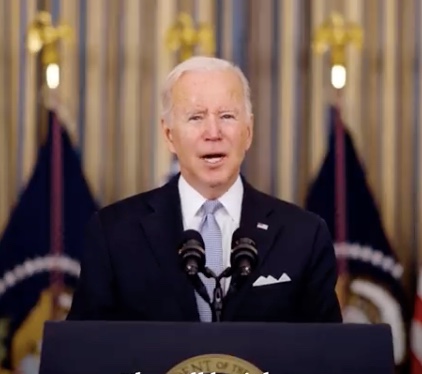Source: Streets Blogs USA
Congress’s $1.2-trillion “infrastructure” bill passed late on Friday evening and was hailed by a POTUS needing a win as a “once-in-a-generation investment.” Being an infrastructure bill, it will allocate scores of billions of dollars for new and expanded car infrastructure, including $110 billion for new roads and repaired bridges, which will do nothing to reduce our dependence on fossil fuels nor release the grip that car ownership has on the livability of our cities. [See the White House fact sheet here.]
That’s the way infrastructure is done in this country — the feds allocate money, and states tap into it. Advocates for sustainability have long condemned that approach.
“Traditionally, states have spent formula federal transportation funds — which this bill funds to the tune of $300 billion — on expanding highways, an unsustainable practice that locks in years of higher greenhouse gas emissions,” said Corinne Kisner, the executive director of the National Association of City Transportation Officials. “US DOT must hold states to account by closely and transparently tracking how states are spending federal transportation funds, scrutinizing projects that will result in expanded highways, higher greenhouse gas emissions, and more deaths on our streets, and using its authority to more closely assess projects that will harm the environment or increase racial disparities in our transportation system.”
Politico also reported that the bill shelved the “fix-it first” promises that President Biden made when he ran for the White House.
“The House-passed surface transportation bill would have prioritized this kind of ‘fix it first,’ and also would have made states measure and reduce their greenhouse gas emissions,” the outlet reported. “But the House bill got sidelined in favor of the more bipartisan Senate version over the summer.”
Beth Osborne of Transportation for America was particularly bothered by the status quo parts of the bill (and they are legion).
“As we have stated before, the transportation portion of the infrastructure bill spends a lot of money but does not target it to the needs of the day: building strong economic centers, providing equitable access to opportunity, addressing catastrophic climate change, improving safety or repairing infrastructure in poor condition,” she said in a statement issued to Streetsblog on Sunday.
“The administration is confident [it] can make substantial progress on these goals despite the deficiencies in the bill,” she added. “Most states have also promised to use the flexibility they fought for to make marked improvements across these priorities. Both the administration and the states will need to make major changes to their approaches to transportation, but we know they can do it. We stand ready to support this important and challenging work.”
But there is plenty to be excited about in the bill, which passed 228-206, with 13 Republicans joining all but Democrats — a small cohort of progressives who voted no in objection to a deal that shelved a crucial package of social and climate change infrastructure programs known as the Build Back Better Act. (A vote on that already watered-down $1.85-trillion bill is expected before Thanksgiving).
Like all big bills, the nuances aren’t always so easy to tease out quickly (for example, the Wall Street Journal reported that the bill allocates “$50 billion to bolster the country’s infrastructure generally against climate change and cyberattacks,” whatever that means). Still, there is a lot be excited about. Now that we’ve had a chance to reach out to the experts, here are some of the highlights:
Public Transit
The bill allocates $39 billion for public transit, not only to clear up a massive backlog of repairs (in New York City alone, that money could be spent in two years), but also to expand lines, improve accessibility for people with disabilities and help state and local governments buy zero-emission buses (which are barely a part of the U.S. mode share right now).
For now, leaders of transit systems nationwide are pleased.
“The more than $10 billion we are expected to receive as part of this game-changing legislation will go toward vital capital projects and accelerate efforts to modernize mass transit in the region,” said Janno Lieber, the CEO of the Metropolitan Transportation Authority, which runs the New York metro region’s sprawling commuter rail, subway and bus system, the largest in the nation.
But advocates said more crucial transit funding is awaiting in the Build Back Better Act.
“We eagerly await passage of the Build Back Better Act, with its $10 billion to improve access to transit in low-income communities, which would mark a historic advance toward transportation equity,” said Danny Pearlstein, the spokesman for Riders Alliance, a transit advocacy group in New York City.
Passenger and freight rail
The bill would provide $66 billion to improve Amtrak’s Northeast Corridor, as well as other routes.
The Amtrak-loving president had sought $80 billion, but the $66 billion represents the largest federal investment in Amtrak since its founding 50 years ago.
The bill would also “alter Amtrak’s stated mission to focus on ‘the intercity passenger rail needs of the United States,’ rather than turning a profit or at least breaking even, something the system hasn’t done since its creation in 1971,” the WSJ reported.
But…
Sean Jeans-Gail, vice president for the Rail Passengers Association, told Politico that the money won’t be enough to create a true transformation in the country’s passenger rail system, like creating new service corridors.
“He noted that much of the money could be eaten up with basic maintenance needs like track upgrades, upholstery of train cars and station ventilation,” Politico reported.
A dystopian future?
Carlton Reid of Forbes noticed something disquieting buried in the bill. “An easy-to-miss part of the Act also formalizes the acceptance of so-called ‘vehicle to everything’ (V2X) technology that, on the face of it, promises enhanced safety on the roads for pedestrians and cyclists. However, experts warn there are critical downsides to the deployment of such technology,” he wrote.
In short, the National Highway Safety Administration will “expand vehicle-to-pedestrian research efforts focused on incorporating bicyclists and other vulnerable road users into the safe deployment of connected vehicle systems.” The goal is to have cars — eventually autonomous ones — “see” cyclists and pedestrians because those vulnerable road users will all (presumably) be equipped with chips or beacons to alert the cars to their presence.
Putting aside the fact that such systems have long had difficulties identifying cyclists, Reid cautions that the long-term goal is to require bikes and pedestrians to be wearing beacons — which will lead to pedestrians and cyclists being blamed for their own deaths if, for example, the way to take a walk without their phone, their phone battery dies, or they simply can’t afford the technology (the vast majority cyclists, for example, are not well off).
“Or perhaps you forgot to turn off airplane mode? Smash: you’re dead, say critics of the technology, pointing out that it would be your fault for assuming, wrongly, that you were protected from being hit by connected cars and trucks,” Reid wrote. “The auto industry is interested in getting pedestrians and cyclists to transmit real-time location information because it’s perhaps the only way AVs can operate in dense cities.”
A new way to tax drivers?
David Zipper of the Harvard Kennedy School and a longtime transportation expert, noticed some small print requiring the feds to “establish a pilot program to demonstrate a national motor-vehicle per-mile user fee.”
Currently, the National Highway Trust Fund is funded with an existing gasoline tax (which has not increased in 28 years and never fully replenishes the trust fund anyway. A new way of funding roads will be needed as gas-powered cars get better and better mileage and electric cars become a bigger part of the fleet. When Transportation Secretary Pete Buttigieg mentioned a vehicle-miles-traveled tax earlier this year, he was pilloried, even though it is increasingly vital.
Looking ahead
As we previously reported, the real good stuff is buried in the Build Back Better Act, which is now supposed to pass later this month. Lydia DePillis, of ProPublica, did an epic weekend-long thread that revealed the transportation goodies (beyond billions for housing, health care and climate resiliency) in that bill:
- $100 million for the Forest Service to rebuild trails, “with a priority on trails that provide to underserved communities access to National Forest System land.”
- $2 billion to help corporations and port operators replace dirty vehicles with clean ones.
- $95 million in grant money to increase urban composting.
- $5 billion in loans to communities whose economies are closely associated with fossil fuel extraction and production.
- $4 billion to help heavy industry decarbonize.
- An end to oil exploration leases in the Arctic National Wildlife Refuge.
- Close to $6 billion to help the Postal Service and the General Services Administration buy zero-emission vehicles.

















This bill is a joke! Nothing will change on our roads or highways
It’s money for the Green Néw Deal. How about dealing with the port backlog, getting goods off the ships to the dock and to the stores? It might even help the economy and slow down the runaway inflation…. But that would mean adults are in charge. Right now we’ve got inexperienced idealogues in the sandbox playing make-believe.